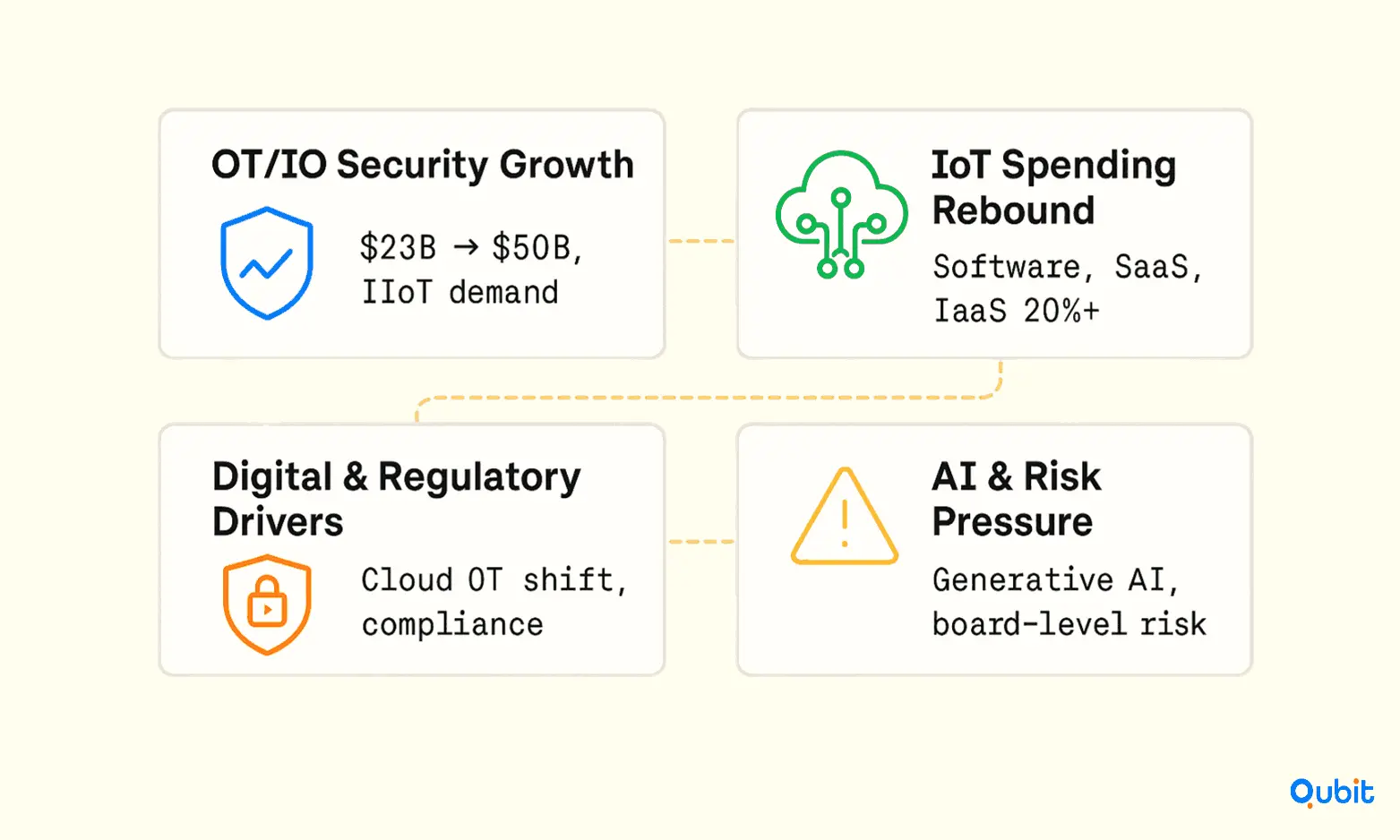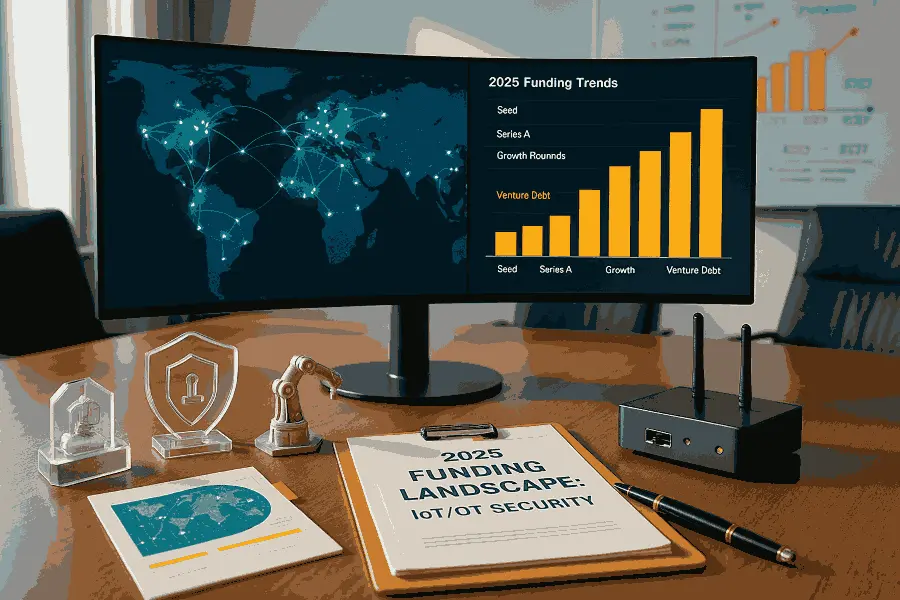The IoT/OT security startup landscape in 2025 is marked by rapid digitalization, a surge in cyber threats, and a funding environment that is both competitive and full of opportunity. As operational technology (OT) and Internet of Things (IoT) systems become increasingly interconnected—and essential to critical infrastructure—the demand for robust security solutions has never been greater. For founders and investors alike, understanding the funding dynamics, valuation trends, and strategic priorities shaping this market is crucial for success.
This article provides a comprehensive view of the funding landscape for IoT/OT security startups in 2025, drawing on the latest market data, investor sentiment, and startup strategies.
Let's jump right in!
Market Overview: Growth, Drivers, and Challenges
OT Security Market Growth and IoT Acceleration

The operational technology (OT) security market is projected to grow from $23.47 billion in 2025 to $50.29 billion by 2030, at a robust CAGR of 16.5%. This expansion is driven by the proliferation of IIoT (Industrial Internet of Things) devices, rising cyberattacks on critical infrastructure, and stricter regulatory mandates. Organizations across manufacturing, energy, and utilities are deploying more smart sensors and connected equipment, increasing both operational efficiency and the attack surface for cyber threats.
IoT enterprise spending is expected to rebound in 2025 after a sluggish 2024, when growth slowed to 10%—the lowest rate in over a decade. Notably, IoT software and connectivity services have remained resilient, with SaaS and IaaS segments supporting IoT deployments growing at over 20% YoY. This suggests that software-driven security solutions and managed services are particularly attractive to investors and customers, even during market slowdowns.
Key Funding Drivers
- Digital Transformation: The shift to digitized, cloud-connected OT environments increases both efficiency and vulnerability, driving demand for advanced security frameworks.
- Regulatory Pressure: Governments worldwide are tightening cybersecurity regulations for critical infrastructure, making compliance a key motivator for security investment.
- AI and Analytics: The integration of AI for threat detection and response is now a must-have, with generative AI enabling real-time anomaly detection and adaptive defenses.
- Physical and Financial Risk: High-profile incidents (e.g., ransomware attacks on power grids) have highlighted the real-world impact of OT security failures, making investment in this space a board-level priority.
Market Challenges
Despite strong growth, the IoT/OT security sector faces several challenges:
- Securing Legacy Systems: Many industrial environments still rely on outdated hardware and software, complicating security upgrades.
- Talent Shortages: The need for specialized skills in both OT and cybersecurity continues to outpace supply.
- Procurement Costs: Comprehensive security solutions require significant investment, often deterring SMEs from full-scale adoption.
- Complexity and Integration: The convergence of IT and OT systems introduces new vulnerabilities and integration headaches.
Funding Trends: Where the Money Is Flowing
Investment Activity and Deal Flow
Cybersecurity remains one of the most active and well-funded sectors in tech, with IoT/OT security occupying a unique and increasingly prominent niche. While cloud security, data security, and IAM command the highest valuation multiples, OT/IoT security is now seen as an undervalued sector with strong upside for both investors and acquirers.
- Deal Stages: Over half of deals to connected enterprise security startups occur at the seed or Series A stage, indicating robust early-stage interest.
- Software vs. Hardware: In late 2024, 45% of the top 20 IoT startup investments were software-focused, reflecting a shift toward scalable, recurring-revenue models.
- Corporate Venture Capital: Major industrial and tech players (e.g., GE, Samsung, Intel, Google) are actively investing in OT and IoT security startups, seeking both strategic advantage and financial return.
- Geographic Hotspots: North America and Asia Pacific remain the largest markets, with Asia’s growth fueled by rapid industrialization and digital adoption.
Valuation Multiples and Benchmarking
Valuations for IoT/OT security startups vary widely, depending on business model, growth rate, and strategic relevance:
- Revenue Multiples: While public cybersecurity companies are seeing more conservative valuations in 2025, private funding and M&A activity remain robust in high-demand segments. OT/IoT security startups are often valued at a discount to cloud/IAM peers, but this is shifting as the market matures and high-profile breaches increase urgency.
- ARR and Funding Benchmarks: Foundational metrics such as ARR, growth rate, and customer logo quality remain central to credible valuation analysis. Early-stage startups with strong ARR growth and blue-chip customers can command premium multiples, especially if they offer SaaS or managed service models.
Fundraising across cybersecurity verticals involves diverse deal structures and investor criteria. Cybersecurity startup fundraising guide walks through the capital models, growth-stage expectations, and trend insights founders need across network security, application protection, and beyond.
Startup Strategies: What’s Winning Funding in 2025
1. AI-Driven Threat Detection and Response
Startups leveraging AI and machine learning for real-time threat detection, anomaly analysis, and automated response are at the forefront of investor interest. Generative AI is being used to analyze vast data streams from industrial systems, predict threats, and orchestrate rapid mitigation—capabilities that appeal to both enterprise buyers and acquirers.
IoT and OT security funding starts with choosing the right capital model funding IoT/OT security startups guide lays out the strategies, investor benchmarks, and timing that founders in this space rely on.
2. Cloud-Native and Edge Security Solutions
With workloads moving to the cloud and edge, solutions that secure data and devices across hybrid environments are in high demand. Cloud-based OT security platforms offer scalability and easier integration, while edge security addresses latency and local processing needs.
3. Regulatory Compliance and Risk Management
Startups offering tools for compliance automation, risk assessment, and reporting are increasingly attractive, as organizations face mounting regulatory scrutiny. These solutions help enterprises navigate complex requirements and demonstrate due diligence to regulators and insurers.
4. IT/OT Convergence and Unified Security Platforms
The convergence of IT and OT systems has created demand for unified platforms that provide end-to-end visibility, network segmentation, and incident response across both domains. Startups that can bridge this gap and offer seamless integration are well-positioned to capture market share.
5. Managed Security Services for SMEs
Given the high cost and complexity of OT security, managed service providers (MSPs) targeting small and medium enterprises are gaining traction. These startups offer subscription-based security monitoring, incident response, and compliance support, lowering the barrier to adoption for resource-constrained organizations.
Funding Sources: Who’s Investing and Why
Venture Capital and Growth Equity
Traditional venture capital remains the primary source of funding for IoT/OT security startups, with a focus on early-stage rounds (seed, Series A, Series B). Investors are seeking:
- Recurring Revenue Models: SaaS and managed services are favored for their predictability and scalability.
- Strong ARR Growth: Startups with 2x+ YoY ARR growth and expanding customer bases stand out.
- Defensible Technology: Patents, proprietary AI models, and deep integration capabilities are key differentiators.
Corporate Venture Capital
Corporate VCs from industrial, energy, and tech giants are highly active in the space, often co-investing with traditional VCs or leading strategic rounds. These investors bring not only capital but also access to customers, distribution channels, and industry expertise.
Strategic Acquisitions and M&A
Given the urgent need for OT/IoT security, established players are actively acquiring startups to fill product gaps and accelerate innovation. Startups with unique technology, proven deployments, or regulatory certifications are prime targets for M&A.
Government Grants and Public Funding
In regions where critical infrastructure protection is a national priority, government grants and incentives are supporting early-stage innovation. This is particularly true in Asia Pacific and Europe, where public-private partnerships are common.
Market Outlook: Trends Shaping the Next Wave
1. Digitization and Cloud Adoption
The digitization of operational environments and migration to cloud platforms are expanding the attack surface and driving demand for scalable, flexible security solutions.
2. AI and Automation
AI-powered security platforms are becoming standard, enabling proactive defense, rapid response, and continuous adaptation to evolving threats.
3. Regulatory Evolution
Stricter regulations around critical infrastructure and data privacy are raising the bar for compliance, creating both challenges and opportunities for startups.
4. Talent and Skills Gap
The shortage of skilled OT security professionals is driving demand for automation, managed services, and user-friendly platforms.
5. Edge and 5G Integration
As industrial environments adopt edge computing and 5G connectivity, startups offering security solutions tailored to these architectures are gaining investor attention.
Events and Ecosystem: Where to Connect and Learn
Industry events remain vital for networking, showcasing innovation, and staying ahead of trends. In August 2025, top gatherings such as BlackHat USA and the Advanced Manufacturing Expo will spotlight the latest in industrial IoT, cybersecurity, and automation. These events provide invaluable opportunities for startups to connect with investors, partners, and customers.
Valuation Benchmarks and Metrics: What Investors Expect
- ARR Multiples: OT/IoT security startups are typically valued at 6–10x ARR for high-growth SaaS models, with discounts or premiums depending on customer concentration, technology, and market timing.
- Growth Rate: 2x+ YoY ARR growth is the standard for Series A/B rounds.
- Customer Logos: Enterprise deals, especially with critical infrastructure operators, can command higher valuations.
- Retention and Expansion: High net revenue retention (>100%) and expansion revenue signal product-market fit.
- Burn Multiple: Investors favor startups with burn multiples below 3x, indicating capital efficiency.
For more on ARR benchmarks and financial modeling, see our cybersecurity startup fundraising guide.
Actionable Tips for Founders
- Focus on SaaS and Managed Services: Recurring revenue models are favored by both VCs and acquirers.
- Demonstrate Regulatory Readiness: Build compliance features and obtain relevant certifications early.
- Leverage AI and Automation: Highlight how your solution uses AI for real-time detection and response.
- Build Strategic Partnerships: Engage with corporate VCs and industry leaders for co-development and go-to-market support.
- Showcase Customer Wins: Secure and publicize deployments with marquee customers, especially in critical infrastructure sectors.
- Prepare for Due Diligence: Maintain robust financials, clear IP ownership, and a strong data room to accelerate funding and M&A discussions.
Conclusion
The funding landscape for IoT/OT security startups in 2025 is dynamic and full of promise. As digital transformation accelerates and cyber threats grow more sophisticated, investors are doubling down on startups that can deliver scalable, AI-driven, and compliant security solutions for the world’s most critical systems. Founders who align their strategies with these market realities, and who can demonstrate strong growth, capital efficiency, and customer traction, will be best positioned to secure funding and drive the next wave of innovation.
Investors are paying attention to IoT and OT security in 2025—but only the most prepared founders will secure the best deals. Avoid wasting time with the wrong investors or generic pitches. Use our Fundraising Assistance service to get expert, industry-aware support that helps you build a compelling narrative, engage the right backers, and close rounds with confidence.
Key Takeaways
- The IoT/OT security market is rapidly growing, driven by IIoT adoption, cyber threats, and regulatory demands.
- Software and managed services dominate funding, with strong early-stage investor interest.
- Valuations vary but are rising as the market matures, especially for SaaS and AI-driven startups.
- AI and cloud adoption are key growth drivers, enabling advanced threat detection and scalable solutions.
- Challenges include legacy system security, high costs, and talent shortages.
- Industry events remain vital for networking and funding opportunities.
Frequently asked Questions
What is driving the surge in IoT/OT security funding in 2025?
The convergence of IT and OT, rapid digitization of industrial environments, and a spike in high-profile cyberattacks on critical infrastructure are pushing organizations to prioritize and invest in advanced security frameworks. Regulatory mandates and the integration of AI for real-time threat detection are also major catalysts


 Back
Back



